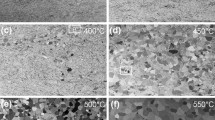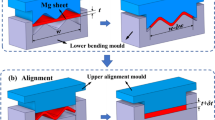Abstract
A high-purity Ti (HP-Ti) sheet was subjected to small strain rolling (10% reduction) with microstructural and textural characteristics examined by electron channeling contrast imaging and electron backscatter diffraction techniques. Particular attentions were paid to misorientation and textural changes aroused by twins in the rolled HP-Ti sheet. Results show that after the 10% rolling, almost all the prior equiaxed grains in the initial specimen are twinned, leading to remarkable grain refinement. The presence of two major misorientation angle peaks around 65° and 85° is ascribed to {11–22}<11–23> and {10–12}<10–11>twinning, respectively, and two minor peaks around 47° and 77° are due mainly to impingement of various variants of such twins. Distinct from earlier work, the small strain rolling is confirmed to be able to induce drastic textural changes in pure Ti sheets: largely reduced texture intensity and appearance of new textural components. This can essentially be attributed to enhanced twinning activity due to much lower impurity contents of the present material. Primary {11–22} twins are mainly responsible for the new textural component of c-axes aligned near the rolling direction with spread, while the component of c-axes parallel to the normal direction is due to reorientation of secondary {10–12} twins. This study clearly demonstrates the capability of small strain rolling to effectively modify both microstructures and textures of the HP-Ti sheet and may shed some light on exploring feasible processings for such materials.
Similar content being viewed by others
References
Banerjee D, Williams J C. Perspectives on titanium science and technology. Acta Mater, 2013, 61: 844–879
Chai L, Wu H, Zheng Z, et al. Microstructural characterization and hardness variation of pure Ti surface-treated by pulsed laser. J Alloys Compd, 2018, 741: 116–122
Mishnaevsky L, Levashov E, Valiev R Z, et al. Nanostructured titanium-based materials for medical implants: Modeling and development. Mater Sci Eng-R, 2014, 81: 1–19
Singh A K, Schwarzer R A. Texture and anisotropy of mechanical properties in titanium and its alloys. Z Metallkd, 2000, 91: 702–716
Wang Y N, Huang J C. Texture analysis in hexagonal materials. Mater Chem Phys, 2003, 81: 11–26
Singh A K, Schwarzer R A. Evolution of cold rolling texture in the binary alloys: Ti-0.4Mn and Ti-1.8Mn. Mater Sci Eng-A, 2001, 307: 151–157
Chun Y B, Yu S H, Semiatin S L, et al. Effect ofdeformation twinning on microstructure and texture evolution during cold rolling of CP-titanium. Mater Sci Eng-A, 2005, 398: 209–219
Bozzolo N, Dewobroto N, Wenk H R, et al. Microstructure and microtexture of highly cold-rolled commercially pure titanium. J Mater Sci, 2007, 42: 2405–2416
Zhong Y, Yin F, Nagai K. Role of deformation twin on texture evolution in cold-rolled commercial-purity Ti. J Mater Res, 2008, 23: 2954–2966
Zherebtsov S V, Dyakonov G S, Salem A A, et al. Formation of nanostructures in commercial-purity titanium via cryorolling. Acta Mater, 2013, 61: 1167–1178
Milner J L, Abu-Farha F, Kurfess T, et al. Effects of induced shear deformation on microstructure and texture evolution in CP-Ti rolled sheets. Mater Sci Eng-A, 2014, 619: 12–25
Sahoo S K, Panda S, Sabat R K, et al. Effect of pre-annealing strains on annealing texture developments in commercially pure (CP) titanium. Philos Mag, 2015, 95: 1105–1124
Sahoo S K, Sabat R K, Sahni S, et al. Texture and microstructure evolution of commercially pure titanium during hot rolling: Role of strain-paths. Mater Des, 2016, 91: 58–71
Liu N, Wang Y, He W, et al. Microstructure and textural evolution during cold rolling and annealing ofcommercially pure titanium sheet. Trans Nonferrous Met Soc China, 2018, 28: 1123–1131
Li L, Li M Q. Grain size model for continuous dynamic re-crystallization of titanium alloy in hot deformation. Sci China Tech Sci, 2018, 61: 1688–1695
Xia J Y, Chai L J, Wu H, et al. EBSD study of microstructural and textual changes of hot-rolled Ti-6Al-4V sheet after annealing at 800°C. Acta Metall Sin (Engl Lett), 2018, 31: 1215–1223
Wasz M L, Brotzen F R, McLellan R B, et al. Effect of oxygen and hydrogen on mechanical properties of commercial purity titanium. Int Mater Rev, 1996, 41: 1–12
Yu Q, Qi L, Tsuru T, et al. Origin of dramatic oxygen solute strengthening effect in titanium. Science, 2015, 347: 635–639
Conrad H. Effect of interstitial solutes on the strength and ductility of titanium. Prog Mater Sci, 1981, 26: 123–403
Bozzolo N, Chan L, Rollett A D. Misorientations induced by deformation twinning in titanium. J Appl Crystlogr, 2010, 43: 596–602
Zaefferer S, Elhami N N. Theory and application of electron channelling contrast imaging under controlled diffraction conditions. Acta Mater, 2014, 75: 20–50
Chai L J, Wang S Y, Wu H, et al. α→β Transformation characteristics revealed by pulsed laser-induced non-equilibrium microstructures in duplex-phase Zr alloy. Sci China Tech Sci, 2017, 60: 1255–1262
Chai L, Chen B, Wang S, et al. Microstructural changes of Zr702 induced by pulsed laser surface treatment. Appl Surf Sci, 2016, 364: 61–68
Bunge H-J, Morris P R. Texture Analysis in Materials Science: Mathematical Methods. London: Butterworths Press, 1982
Wright S I, Nowell M M, Field D P. A review of strain analysis using electron backscatter diffraction. Microsc Microanal, 2011, 17: 316–329
Guo N, Li D, Yu H, et al. Annealing behavior of gradient structured copper and its effect on mechanical properties. Mater Sci Eng-A, 2017, 702: 331–342
Chun Y B, Battaini M, Davies C H J, et al. Distribution characteristics of in-grain misorientation axes in cold-rolled commercially pure titanium and their correlation with active slip Modes. Metall Mat Trans A, 2010, 41: 3473–3487
Britton T B, Dunne F P E, Wilkinson A J. On the mechanistic basis of deformation at the microscale in hexagonal close-packed metals. Proc R Soc A, 2015, 471: 20140881
Xu S, Gong M, Jiang Y, et al. Secondary twin variant selection in four types of double twins in titanium. Acta Mater, 2018, 152: 58–76
Wronski S, Jedrychowski M, Tarasiuk J, et al. Microstructure evolution of titanium after tensile and recrystallisation. Mater Sci Eng-A, 2017, 692: 113–126
Ghosh A, Singh A, Gurao N P. Effect of rolling mode and annealing temperature on microstructure and texture of commercially pure-titanium. Mater Charact, 2017, 125: 83–93
Won J W, Kim D, Hong S G, et al. Anisotropy in twinning characteristics and texture evolution of rolling textured high purity alpha phase titanium. J Alloys Compd, 2016, 683: 92–99
Sinha S, Pukenas A, Ghosh A, et al. Effect of initial orientation on twinning in commercially pure titanium. Philos Mag, 2017, 97: 775–797
Stanford N, Carlson U, Barnett M R. Deformation twinning and the hall-petch relation in commercial purity Ti. Metall Mat Trans A, 2008, 39: 934–944
Wang T, Li B, Li M, et al. Effects of strain rates on deformation twinning behavior in α-titanium. Mater Charact, 2015, 106: 218–225
Chai L J, Xia J Y, Zhi Y, et al. Deformation mode-determined mis-orientation and microstructural characteristics in rolled pure Zr sheet. Sci China Tech Sci, 2018, 61: 1346–1352
Preuss M, da Fonseca J Q, Allen V, et al. Twinning in structural material with a hexagonal close-packed crystal structure. J Strain Anal Eng Des, 2010, 45: 377–390
Author information
Authors and Affiliations
Corresponding authors
Additional information
This work was supported by the Fundamental and Cutting-Edge Research Plan of Chongqing (Grant No. cstc2018jcyjAX0299), and the Technology Innovation and Application Demonstration Project of Chongqing (Grant No. cstc2018jszx-cyzdX0080). Critical comments from the reviewers of this paper are also gratefully appreciated.
Rights and permissions
About this article
Cite this article
Dai, J., Zeng, L., Li, Z. et al. Misorientation characteristics and textural changes induced by dense twins in high-purity Ti sheet after small strain rolling. Sci. China Technol. Sci. 62, 1968–1975 (2019). https://doi.org/10.1007/s11431-019-9555-9
Received:
Accepted:
Published:
Issue Date:
DOI: https://doi.org/10.1007/s11431-019-9555-9




